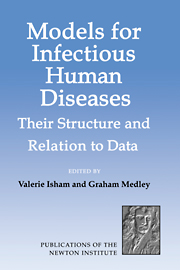Book contents
- Frontmatter
- Contents
- Introduction
- Participants
- Non-Participant Contributors
- Part 1 Transmissible diseases with long development times and vaccination strategies
- Overview of data analysis: diseases with long development times
- HPV and cervical cancer
- An age-structured model for measles vaccination
- Invited Discussion
- Invited Discussion
- Piece-wise constant models to estimate age- and time-specific incidence of toxoplasmosis from age- and time-specific seroprevalence data
- New methodology for AIDS back calculation
- Imperfect HIV vaccines, the consequences for epidemic control and clinical trials
- Feasibility of prophylactic HIV-vaccine trials: some statistical issues
- The design of immunisation programmes against hepatitis B virus in developing countries
- The effect of different mixing patterns on vaccination programs
- Optimal vaccination patterns in age-structured populations I: the reproduction number
- Optimal vaccination patterns in age-structured populations II: optimal strategies
- Part 2 Dynamics of immunity (development of disease within individuals)
- Part 3 Population heterogeneity (mixing)
- Part 4 Consequences of treatment interventions
- Part 5 Prediction
Overview of data analysis: diseases with long development times
Published online by Cambridge University Press: 04 August 2010
- Frontmatter
- Contents
- Introduction
- Participants
- Non-Participant Contributors
- Part 1 Transmissible diseases with long development times and vaccination strategies
- Overview of data analysis: diseases with long development times
- HPV and cervical cancer
- An age-structured model for measles vaccination
- Invited Discussion
- Invited Discussion
- Piece-wise constant models to estimate age- and time-specific incidence of toxoplasmosis from age- and time-specific seroprevalence data
- New methodology for AIDS back calculation
- Imperfect HIV vaccines, the consequences for epidemic control and clinical trials
- Feasibility of prophylactic HIV-vaccine trials: some statistical issues
- The design of immunisation programmes against hepatitis B virus in developing countries
- The effect of different mixing patterns on vaccination programs
- Optimal vaccination patterns in age-structured populations I: the reproduction number
- Optimal vaccination patterns in age-structured populations II: optimal strategies
- Part 2 Dynamics of immunity (development of disease within individuals)
- Part 3 Population heterogeneity (mixing)
- Part 4 Consequences of treatment interventions
- Part 5 Prediction
Summary
Introduction
Among diseases with long development times – from inception to diagnosis, from diagnosis to death, or both – feature breast and cervical cancer, endstage organ failure and cardiovascular disease; all four have aspects in common with HIV disease, but its transmissibility by many routes sets it apart from the rest.
Breast and cervical cancers are detectable when asymptomatic (or precancerous) by screening; treatment of screen-detected lesions saves lives. Blood pressure lowering drugs reduce the incidence of stroke and coronary heart disease. An HIV antibody positive test leads to consideration of personal measures to prevent onward transmission of HIV disease and, from clinical management, to a better quality and length of HIV infected life, but as yet no cure. Cervical cancer, like HIV disease, is viral in origin and sexual transmission is implicated in its spread. Transplantation shares with HIV disease an immunological basis, recency, and unusual intensity of patient monitoring through laboratory markers.
Section 2 reviews the statistical problems posed by these other four applications, all of high public health or political profile, before consideration in Section 3 of chronic disease processes generally, and the transmissibility of HIV disease. Section 4 focusses on three data analytic themes in HIV disease – progression markers, incubation distribution and infectivity – and briefly reviews how they have been tackled. Future statistical directions in HIV disease are outlined in Section 5 with emphasis on transmission study design and overview, and on the non-proportionality over time of covariate influences. This includes unmeasured (frailty) as well as measured (and appropriately parametrized) covariates.
- Type
- Chapter
- Information
- Models for Infectious Human DiseasesTheir Structure and Relation to Data, pp. 3 - 27Publisher: Cambridge University PressPrint publication year: 1996

